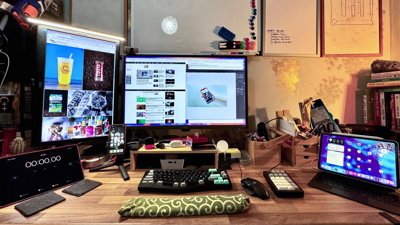A tool has been created to help independent repair outfits fix a common issue with the MacBook Pro and MacBook Air, one that would normally be fixed by Apple because of software elements.
Apple has been under fire for some time for its use of serialization and other restrictions that make it difficult for repair shops to actually fix Apple's hardware without access to Apple's tools and part supplies. While there is still a considerable amount of work to go, one YouTube video claims there is a solution to at least one component failure that no longer requires Apple's intervention.
In May, long-time component-level repair advocate YouTuber Louis Rossmann published a video about an issue on MacBook Pro and MacBook Air models that won't power down or turn on when the lid is closed or opened. The problem was traced back to a small element referred to as an angle sensor or sleep sensor, which is supposed to automatically put the MacBook to sleep or wake it depending on the position of the lid.
If the sensor is not working, then the MacBook lid cannot switch between sleeping and waking modes.
Previously, replacing the sensor with an identical component from another MacBook wouldn't work, despite being practically the same component hardware-wise. That meant there was something software-related that needed to be done.
In a video published on Friday, Rossman said it's because the replacement sensor is not calibrated to the MacBook it's being put into. Furthermore, Rossmann adds that the MacBook with a replacement uncalibrated sensor doesn't go to sleep "for your security."
It was still fixable by repair shops in cases where the sensor's connection had corroded, as scraping away the corrosion could make the sensor work once more. However, this wasn't guaranteed to work.
Instead of performing the repair for customers, repair shops would often refer them to Apple to fix it. In some cases, customers were informed that the repair would require a full replacement of the motherboard of the MacBook, which could end up costing $1000.
Fixing the problem, not the issue
In Saturday's YouTube video, an actual fix to the issue is demonstrated via the use of a new third-party tool and without going through Apple. Produced by Notebook Nerds of Germany, the nerd.tool.1 is said to fix the sleep sensor problem with a recalibration of the new component.
Connecting the replacement sensor to the lid and to the tool, the fix takes a few minutes and two button presses to complete. Afterwards, it is demonstrated that the sensor works as originally intended.
The tool's creation is certainly a step forward for Rossmann and the Right to Repair movement, as it is a workaround for a fix that would usually require Apple's intervention to actually complete. As an entirely third-party-based repair using parts sourced outside of Apple's support system, it does open the door for more repairs performed without Apple's involvement.
However, it's still only a small step for Right to Repair advocates, due to issues such as the serialization of parts.
Apple has taken steps to allow third-party repair shops to repair hardware using genuine Apple parts and tools under its independent repair provider program. However, there have been complaints that Apple is slow to respond and that the cost of the parts is expensive, making it difficult for repair shops to effectively compete against Apple's own support system.
The new tool and its ability to enable a fix for a common problem while also using parts sourced separately from Apple does give hope that other similar breakthroughs could come to fruition in the future.
 Malcolm Owen
Malcolm Owen







-m.jpg)






 Christine McKee
Christine McKee


 Sponsored Content
Sponsored Content

 Amber Neely
Amber Neely











7 Comments
From looking at the video the angle sensor is mounted on its own small board that is connected to the logic board by a cable. So why is Apple forcing customers to buy a whole new logic board?
It is yet another example, rife across many sectors in society, where 'security' just happens to be in full alignment with 'revenue protection'. Where the 'security' justification for profit can be employed, invariably it will be.